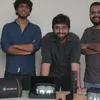How this product manager and musician started a VR startup for digital heritage experiences
Bengaluru-based Who VR is a patent-pending startup that provides digital heritage experiences.
In 2017, while composing music, Ajit Padmanabh had a vision of music enthusiasts gathered outdoors, wearing Head-Mounted Devices (HMDs), and bobbing their heads to great music. This was community gameplay – something he had conceptualised as a stage setup for his music concerts.
He took this idea and moulded it to create an immersive experience to revisit our culture and heritage. In 2018, he started Who VR, a patent-pending, pioneering VR/AR startup out of Bengaluru, with a focus on digital heritage.
“Who VR has a deeper purpose of preserving our heritage, not only from tangibles like the monuments' architecture (and the science behind it), but also to provide a deep experience into the intangibles – from the various bodies of knowledge that our elders wrote and converting it into immersive visuals, spatial audio, or anecdotal narratives,” Ajit, who has been a Product Manager for the likes of Infosys, and is also a musician, tells YourStory.
The startup offers an immersive room, which is a kiosk or an Experience Centre that is sized to fit six to 12 people at a time, enabling a community experience of Who VR. “We provide turnkey solutions incorporating both hardware and software along with an immersive room experience at select locations,” he explains.
Additionally, the Experience Centre houses the HMDs (HTC Vive or Oculus Quest) as well as the neuro-headsets, EMOTIV, which measures the user’s vitals as well as EEG before and after the experience. The Experience Centre comes with an in-house, digital payment enabled ticketing software for smooth and seamless transactions.
"Our services range from immersive edutainment in VR. Time-travel to ancient sites, recreate the glorious sights and sounds of the era gone by, and rebuild ancient sites to tabletop experiences on AR,” says Ajit.

Who VR team doing 360-degree photography setup at Lepakshi, Andhra Pradesh
From music to digital heritage
When he germinated the idea, Ajit reached out to his contacts in the music industry with his rather ambitious stage setups. The idea that his ambitious (and implausible) stage setups could be delivered to his fans through HMDs in Virtual Reality (VR) was no less than a eureka moment. Thus, was seeded the thought of music concerts in VR.
He joined various online groups on Facebook and LinkedIn, and started absorbing the trends and various possibilities in the market. Ajit pitched the idea in one of the groups and got a lead from the admin on "The Wave VR" (now known as The Wave and showcasing music concerts for world-renowned artists and performers).
He followed up and had a couple of discussions with Adam Arrigo, CEO and Co-founder of Silicon Valley-based company Wave.
At that time, they were looking for artists to try out their platform and to Ajit's dismay, he didn’t have a headset to even get onto the platform. Meanwhile, the post on Facebook had received another response, this time from a VR startup in Chennai.
This startup went ahead to become Who VR’s partner and has been consistently enabling prototyping with countless ideations and improvisations.
In 2018, at a serendipitous event, Ajit shared his idea with a prospective employer, which led him to read the book Stealing Fire by Jamie Wheal and Steven Kotler – which talked about scenarios similar to what Who VR was trying to achieve.

Chanting near sanctum sanctorum at Veerabhadreshwar temple at Lepakshi
Building the network
He was advised to connect with investors in Silicon Valley – all of whom were equally excited about the concept.
In 2019, Ajit connected with the founders of Bharath Gyan – Dr DK Hari and Dr DK Hema Hari – who agreed to be Who VR’s knowledge partners. The platform is a research initiative engaged in collating the knowledge of India. With the core team formed and multi-disciplined partnerships in place, the time was right to release a prototype.
So, Ajit and team ensued on a series of trips to the ancient Veerabhadreshwara temple at Lepakshi, Andhra Pradesh after seeking the permission from the Archaelogical Survey of India to perform the shoots. They recorded Vedic chants at the temple for neuro-research, took 360-degree captures of the temple, and also carried out an immersive time-travel capsule of the giant monolith Nandi. The team also created a 3D-model of Nandi and a narrative with sights and sounds of the 16th and 21st century.
The core team includes four people, including the founder. With content partners, neuro-research partners, VR technology partners, the number goes up to 12.
The product
Who VR has content partners across verticals. The team houses these experiences on their apps, PCs, as well as their HMDs.
Technologically, Who VR’s platform works on the popular Head-Mounted Devices (HMDs) in the market – HTC Vive and Oculus Quest. Pending a patent, it leverages Unity and Unreal Engine as its software engines, which are widely used in game development as well as AR/VR development.
“At ancient sites, we perform 360-degree camera captures as well as a 3D scan of the entire temple complex up to an accuracy of 1mm, thereby capturing the vast expanse of the land as well as the intricate details of sculptures, bringing us closer to the magical world of our ancients and elders. These scans are ported to software for resultant renders and VFX during post-production, along with binaural soundscapes of healing chants interspersed in these immersive experiences with authentic and historically researched narratives,” says Ajit.
For VR Music Concert, the team leverages bodysuits, gloves, motion capture (MoCap), and LipSync technologies to create a digital avatar of an artist whose live actions are mimicked by the avatar.

Ajit Padmanabh with Who VR team
Revenue and market
Who VR’s revenue model is multifold, owing to its focus on content creation as well as curation.
For immersive experiences at specific locations like heritage sites and airports, the team operates on a subscription model that employs a ticketed system tracking the usage and payment of consumers.
“With various travel and tourism agencies that provide VR content to their customer, we work on a licensing model of our content (including wellness chants),” says Ajit.
The need for AR and VR experiences is growing fast. Delhi-based Augtraveler built an AR app and platform that uses technology and multimedia content to help consumers learn about and interact with sites and monuments. Another of its competitors is VR startup Scapic, which was recently acquired by Flipkart. Globally, there are several apps like HoloMaps and ViewRanger that use virtual mapping and AR to enhance a tourist or visitor’s experience of sites and trails.
Funding and future
Currently bootstrapped, Who VR is in talks with Karnataka government and Government of India to help them capture digital heritage across the state and the country.
“We seek funding for projects undertaken by govt agencies as well as tourism and travel corporations. Additionally, we are looking to venture into gaming and wellness as additional revenue streams,” says Ajit.
With a healthy pipeline ushering in growth in the months to come, Who VR aims to expand its application landscape as well as geographical boundaries to beyond India. Additionally, heritage gaming is emerging as a rich way of retelling history, while also actively participating in it.
"We are looking to maximise on gaming along with mapping of heritage sites as our core,” says Ajit.
Edited by Kanishk Singh










